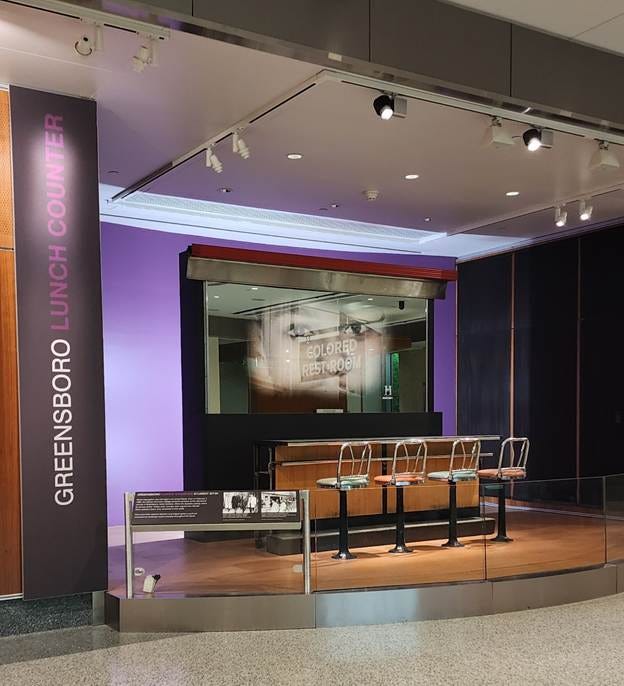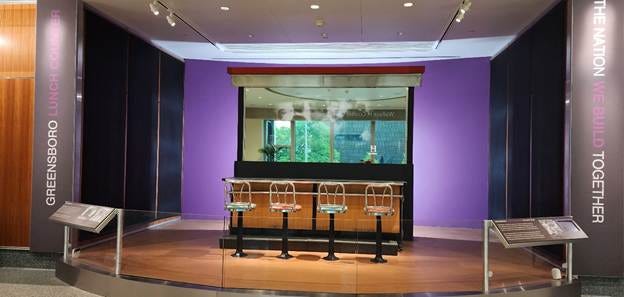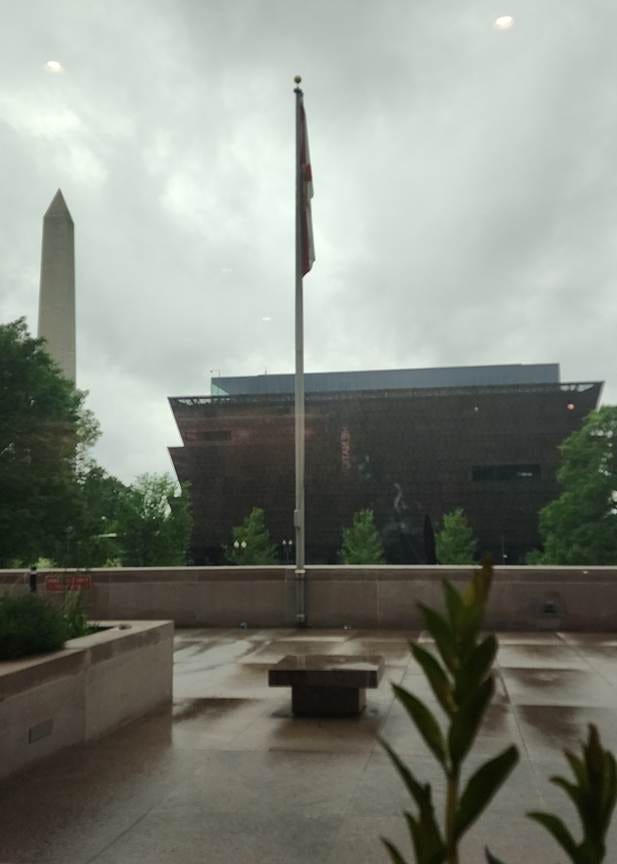Today, April 26, 2025, I spent the afternoon at two of our country’s finest museums, both under the umbrella of the Smithsonian Institution: the National Museum of American History and the National Museum of African American History & Culture. I went there because word had gone out that a very important exhibit, the Greensboro Lunch Counter, was/had been removed. The reports noted that it was going to be removed—that there was so much push-back that it was not yet removed, but it might be.
I was anxious to learn what was going on. We all know of Executive Order 14253 of March 27, 2025, that announced that “the Smithsonian Institution has, in recent years, come under the influence of a divisive, race-centered ideology.”
I am relieved to report that the exhibits in both museums are still there.
Here’s the exhibit at the National Museum of American History. As you sit or stand in front of the exhibit, you can watch a documentary produced by the History Channel on the story of the protest:
The National Museum of American History’s exhibit is strategically located because it looks out at the National Museum of African American History & Culture. When the film is not showing, there is a mirror that reflects the National Museum of African American History & Culture.
If you turn around, you can look out the window at the museum:
Here is the Greensboro exhibit at the National Museum of African American History & Culture. One of the preserved chairs is in the protective case.
The exhibit is interactive: you sit at the counter and view the documentary on protests and view additional information on the counter in front of you. As people got up from the seats, other people quickly took them:
I sat at each exhibit for a while and watched people come, stay, and go. They were people of all ages, races, and genders. They all sat and took in the story. They took pictures. They talked amongst themselves. No one seemed upset or angry. Instead, they were clearly moved by the exhibits—and took away important impressions and memories of their interaction with not just pieces of history—but the people who made that history happen. The people who fought for their civil rights.
These exhibits are necessary to tell the complete story of our past. However, there is one person who wants to bury the stories and get rid of the exhibits because she feels that they just are not what American history should be.
The attack against the Smithsonian has been spearheaded by one of Trump’s cronies, Lindsey Halligan, Esq. You can read all about her here. Importantly, she is not educated in history, but has an interest in it, “particularly the Civil War and the westward expansion of the country” per the article.
She is an attorney who has been supporting Trump and his lawsuits since 2022, including the August 2022 FBI raid of Mar-a-Lago when they were trying to find the classified documents he had on the property.
Since the inauguration, Lindsay has taken over the cultural/historical side Trump’s agenda to get rid of woke culture. She is the one who gave Trump the idea that the Smithsonian needed an ideological overhaul. She is empowered in the Executive Order to do so, with the title of “Assistant to the President for Domestic Policy and the Special Assistant to the President and Senior Associate Staff Secretary.” Her title is very long, but her knowledge of history is not. Her qualifications? She is a “fan” of history.
I am part of the generation that witnessed the Civil Rights movement, including the sit-in at the Greensboro Lunch Counter, and all the events that occurred afterward so that black Americans could be granted the “right” to be served at a lunch counter for a meal they would pay for. Their nonviolent protest led to other protests that led to the passage of the Civil Rights Act in 1964. Much African American history is painful. But it is part of our history—and it must be acknowledged. We cannot erase it. We must keep it alive and present—because we cannot just pass by this history and literature and art. We learn and grow from it. We become a better country because of it.
I have a lot of experience in defending the humanities. For around 35 years, I taught in higher education: literature, writing, speech. I ran an English/Humanities program. I also was the Chair of the Humanities Department. Believe me, from students to other higher education administrators to the general public, I am used to arguing for the necessity for having students take those general education courses in history, art, communication studies, language, and African American studies. All disciplines of the humanities matter: whether you like it or not, whether it makes you feel uncomfortable or not. The point is you study it. You examine it. You learn from it. You take joy in it. You share it with the next generations.
So, when I hear someone like Halligan, who is clearly not a scholar in any of these fields say, “We will be working with a diverse group of people with varying fields of expertise to make sure that the Smithsonian portrays a fair and balanced representation of American history, culture and art,” I would like to volunteer to be a part of that team. For it is obvious that this lady doesn’t have the expertise to make a decision as to what is “fair and balanced” when it comes to “American history, culture and art.” She may be a “fan” of history, but it takes a scholar to develop the public education of history, culture, and art presented in a museum, especially the caliber of a Smithsonian Museum.
Perhaps Lindsey is afraid of the power of non-violent protests that introduce and inspire major changes. She certainly needs some education on it, so I refer her to the Library of Congress’ educational materials on the Greensboro Lunch Counter Sit-In. She could also look at the Library of Congress’ collections on African American History. It includes The Civil Rights History Project and the William A. Gladstone Afro-American Military Collection. I hope she looks at the National Park Service’s page on “What is the Underground Railroad?” the one that the National Park Service tried to change by removing the main picture of Harriet Tubman and whitewashing the history of the Underground Railroad. She could also look at my Substack, where I wrote about how the National Park Service brought back the original page after public outcry: https://mbmatthews.substack.com/p/what-is-the-underground-railroad.
In the end, I hope she can realize that the history of the United States cannot be told without including the story of African slaves, the Jim Crow era, and the 1960s Civil Rights Movement. You cannot look at art and ignore the fact that white males dominated that discipline for centuries, both here and in Europe. You cannot look at culture without acknowledging that we are a multi-cultural population—and all our stories deserve to be told in our museums. The museums do not belong to only white people anymore.
In the meantime, we must keep up the fight against this whitewashing of our American heritage.
Before I left the National Museum of African American History and Culture today, I made sure to fill out the feedback kiosk. When asked why I came today, I noted it was to see the Greensboro lunch counter because it is a vital part of American history.
What can you do? Write/email the Smithsonian museums. Email/call your representatives. I hear that there will be a protest on May 3rd outside the National Museum of African American History & Culture. When I have details, I will post them. If you live in the area, plan to attend.
We cannot let our history be whitewashed by people who want to exclude the stories of Americans whose stories make them feel uncomfortable or “not great.”
The truth, the whole truth, and nothing but the truth is the combined narrative of us all.
mbm/4/26/25. The opinions expressed in this post are exclusively my own.








Thank you for this article and for your commitment to the study of humanities. Excellent job of writing this piece and the inclusion of the photos and links!👍💙👏👏👏